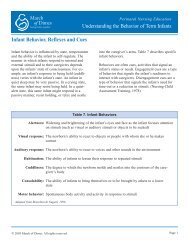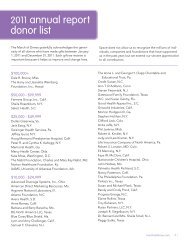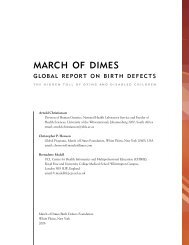Ob Gyn Quality Indicators… - March of Dimes
Ob Gyn Quality Indicators… - March of Dimes
Ob Gyn Quality Indicators… - March of Dimes
You also want an ePaper? Increase the reach of your titles
YUMPU automatically turns print PDFs into web optimized ePapers that Google loves.
LEADING THE QUEST FOR HEALTH <br />
<strong>Ob</strong> <strong>Gyn</strong> <strong>Quality</strong> <strong>Indicators…</strong><br />
What are they and who cares?<br />
Kimberly D. Gregory MD, MPH<br />
Vice Chair Women’s Healthcare <strong>Quality</strong> & Performance Improvement<br />
Department <strong>Ob</strong>stetrics & <strong>Gyn</strong>ecology<br />
Cedars Sinai Medical Center<br />
Pr<strong>of</strong>essor, David Geffen School <strong>of</strong> Medicine &<br />
UCLA School <strong>of</strong> Public Health
Disclosures<br />
I have no financial disclosures<br />
No <strong>of</strong>f label use <strong>of</strong> medications
<strong>Ob</strong>jectives<br />
At the completion <strong>of</strong> this lecture, participant will<br />
be able to<br />
1. Define quality <strong>of</strong> care<br />
2. Identify quality indicators used in women’s health<br />
3. Be familiar with external entities charged with<br />
developing indicators, monitoring and reporting<br />
results<br />
4. Be familiar with strengths and limitations <strong>of</strong><br />
available indicators
What is quality?<br />
“that kind <strong>of</strong> care which is expected to<br />
maximize a measure <strong>of</strong> patient welfare,<br />
after one has taken account <strong>of</strong> the<br />
balance <strong>of</strong> expected gains and losses that<br />
attend the process <strong>of</strong> care in all its parts”<br />
—Donabedian, 1980
What is <strong>Quality</strong>?<br />
High quality care “consistently contributes to the improvement<br />
or maintenance <strong>of</strong> quality and/or duration <strong>of</strong> life<br />
Delineated attributes <strong>of</strong> care that defined quality<br />
— Emphasis on health promotion and disease prevention<br />
— Timeliness<br />
— Informed participation <strong>of</strong> patients<br />
— Attention to scientific basis <strong>of</strong> medicine<br />
— Efficient use <strong>of</strong> resources<br />
American Medical Association, 1984
What is <strong>Quality</strong>?<br />
“Degree to which health services for individuals<br />
and populations increase the likelihood <strong>of</strong><br />
desired health outcomes and are consistent<br />
with current pr<strong>of</strong>essional knowledge”<br />
—Institute <strong>of</strong> Medicine, 1990
health services<br />
— all encompassing<br />
<strong>Quality</strong> Health Care: IOM<br />
— (services: acute, long term, prevention,<br />
promotion; any provider; across all settings)<br />
— patient focused, provider focused, organization<br />
focused<br />
individuals & populations<br />
— applies to individuals, clinicians, institutions,<br />
health plans, and health systems<br />
— different perspectives, stakeholders
<strong>Quality</strong> Health Care: IOM<br />
desired health outcomes<br />
— link between care, outcome (effects on health),<br />
and patient expectations<br />
— implies patient education, participation<br />
increase the likelihood<br />
— good outcome is not guaranteed<br />
poor outcomes occur, despite best possible care<br />
patients do well despite poor quality<br />
— assessing quality requires attention to both<br />
process and outcome
<strong>Quality</strong> Health Care: IOM<br />
consistent with current knowledge<br />
— dynamic, evolving knowledge base<br />
— willing to revise as new knowledge becomes<br />
available
Health Care <strong>Quality</strong>: IOM definition <strong>of</strong> poor quality<br />
Underuse: failure to provide a health service<br />
when it would have produced a favorable<br />
outcome<br />
Overuse: service provided and potential for<br />
harm exceeds the possible benefit<br />
Misuse: appropriate service but a<br />
preventable complication<br />
— “consistency in process” is a pillar <strong>of</strong> quality -<br />
Donabedian
Summary <strong>of</strong> the Essence <strong>of</strong> <strong>Quality</strong><br />
Doing the right thing, the right way, at the<br />
right time!
Donabedian: Concepts Important<br />
for<br />
<strong>Quality</strong> Measurement<br />
Structure: attributes <strong>of</strong> the patient<br />
or health care entity<br />
Process: events or<br />
procedures that happen to<br />
the patient<br />
Outcome: survival, complications,<br />
quality <strong>of</strong> life<br />
Must be able to measure to improve
Healthcare <strong>Quality</strong>—Who Cares?
Healthcare <strong>Quality</strong>—Who Cares?<br />
ACOG WEBTREATS: Performance Measures and<br />
<strong>Quality</strong> Improvement<br />
—as <strong>of</strong> 3/8/11<br />
—20 different agency sponsored websites<br />
— www.acog.org/departments/dept_notice.cfm?recno=10&bulletin=4226;<br />
accessed 4/8/11<br />
— 21 different sponsored websites; accessed 3/1/2012
Healthcare <strong>Quality</strong>—Why Care?<br />
Depends on perspective (stakeholder)<br />
Physician: to maintain pr<strong>of</strong>essionalism, autonomy<br />
Patient: to be healthy, get a good outcome<br />
Payer: ideal employee outcome; optimal employees outcome<br />
(efficiency/trade<strong>of</strong>f/cost effectiveness)<br />
Assume<br />
— Measure to improve<br />
— Individual standardization maximizes system efficiency
Women’s healthcare<br />
—Broad topic<br />
<strong>Ob</strong>/gyn<br />
What do we measure?<br />
—Disappointing dearth <strong>of</strong> indicators<br />
—4 million births; # 1 cause <strong>of</strong> hospital admission<br />
Comparatively few indicators, relative to general adult<br />
population<br />
—<strong>Gyn</strong> is even more sparse
Healthy People 2020<br />
What do we measure?<br />
National Goals or “indicators” <strong>of</strong> the health <strong>of</strong> the nation<br />
— Family Planning (15)<br />
— Maternal, Infant, & Child health (19)<br />
Morbidity & Mortality<br />
Pregnancy health and behavior<br />
Preconception health and behavior<br />
Postpartum health and behavior<br />
— Sexually Transmitted Infections( 9)
HP 2020: Family Planning<br />
Number <strong>Ob</strong>jective Short Title<br />
FP–1 Intended pregnancy<br />
FP–2 Contraceptive failure<br />
FP–3 Emergency contraception available at family planning clinics<br />
FP–4 Health insurance coverage for contraceptive supplies and services<br />
FP–5 Birth spacing<br />
FP–6 Contraceptive use at most recent sexual intercourse<br />
FP–7 Receipt <strong>of</strong> reproductive health services<br />
FP–8 Adolescent pregnancy<br />
FP–9 Abstinence ages 17 and under<br />
FP–10 Use <strong>of</strong> condoms for pregnancy prevention and protection against<br />
disease<br />
FP–11 Dual method use for pregnancy and disease prevention<br />
FP–12 Adolescent Reproductive health education<br />
FP–13 Parent-adolescent communication about reproductive health topics<br />
FP–14 Medicaid eligibility for pregnancy-related care<br />
FP–15 Receipt <strong>of</strong> publicly supported contraceptive services and supplies
HP 2020: Maternal & Infant Health<br />
Morbidity & Mortality<br />
Number <strong>Ob</strong>jective Short Title<br />
MICH–1 Fetal and infant deaths<br />
MICH–2 Deaths among infants with Down syndrome<br />
MICH–3 Child deaths<br />
MICH–4 Adolescent and young adult deaths<br />
MICH–5 Maternal deaths<br />
MICH–6 Maternal illness and complications due to pregnancy<br />
MICH–7 Cesarean births<br />
MICH–8 Low birth weight and very low birth weight<br />
MICH–9 Preterm births
Healthy People 2020<br />
Description Baseline (2007) Goal<br />
MICH-5 Maternal Mortality 12.7/100k 11.3/100k<br />
MICH-6 Complications L&D 31.1% 28.0%<br />
MICH-7.1 NTSV Cesarean 26.5% 23.9%<br />
MICH-7.2 Prior CS 90.8 87.7
HP2020: Maternal & Infant Health<br />
Pregnancy Health & Behaviors<br />
Number <strong>Ob</strong>jective Short Title<br />
MICH–10 Prenatal care (early & adequate)<br />
MICH–11 Prenatal substance exposure<br />
(decrease)<br />
“Developmental”<br />
MICH–12 Childbirth classes<br />
MICH–13 Weight gain during pregnancy
HP 2020: Maternal & Infant Health<br />
Preconception Health and Behaviors (Developmental)<br />
Number <strong>Ob</strong>jective Short Title<br />
MICH–14 Optimum folic acid levels<br />
MICH–15 Low red blood-cell folate concentrations<br />
MICH–16 Preconception care services and behaviors<br />
MICH–17 Impaired fecundity<br />
Postpartum Health and Behavior (Developmental)<br />
MICH–18 Postpartum relapse <strong>of</strong> smoking<br />
MICH–19 Postpartum care visit with a health worker
HP 2020: Sexually Transmitted Infections<br />
Number <strong>Ob</strong>jective Short Title<br />
STD–1 Chlamydia<br />
STD–2 Chlamydia among females<br />
STD–3 Annual screening for genital Chlamydia by Medicaid<br />
STD–4 Annual screening for genital Chlamydia by insurance plans<br />
STD–5 Pelvic inflammatory disease<br />
STD–6 Gonorrhea<br />
STD–7 Primary and secondary syphilis<br />
STD–8 Congenital syphilis<br />
STD–9 Human papillomavirus infection<br />
STD-10 Congenital herpes<br />
Some NCQA<br />
HEDIS measures
AHRQ <strong>Quality</strong> Indicators<br />
Agency Healthcare Research & <strong>Quality</strong><br />
(AHRQ)<br />
Prevention <strong>Quality</strong> Indicators<br />
Inpatient <strong>Quality</strong> Indicators<br />
Patient Safety Indicators
AHRQ Prevention <strong>Quality</strong> Indicators<br />
“Ambulatory care sensitive conditions”<br />
—Hospital admissions that evidence<br />
suggests could have been avoided<br />
through high quality outpatient care<br />
or that reflect conditions that could be less<br />
severe, if treated early and appropriately<br />
—Represent current state <strong>of</strong> the art in<br />
measuring the outcomes <strong>of</strong> preventive and<br />
outpatient care thru analysis <strong>of</strong> inpatient<br />
discharge data
AHRQ Prevention <strong>Quality</strong> Indicators<br />
16 “ambulatory care sensitive conditions”<br />
Bacterial pneumonia<br />
Dehydration<br />
Pediatric gastroenteritis<br />
UTI<br />
Perforated appendix<br />
Low Birth weight<br />
Angina w/o procedure<br />
CHF<br />
Hypertension<br />
Adult asthma<br />
Pediatric asthma<br />
COPD<br />
Diabetes-short term<br />
Diabetes-long term<br />
Uncontrolled diabetes<br />
Lower extremity amp
AHRQ Prevention <strong>Quality</strong> Indicators<br />
16 “ambulatory care sensitive conditions”<br />
Low Birth weight<br />
Only 1/16 specific to<br />
OB<br />
Additional 8 have<br />
potential applicability<br />
Hypertension<br />
Adult asthma<br />
Bacterial pneumonia<br />
Perforated appendix<br />
UTI<br />
Diabetes-short term<br />
Diabetes-long term<br />
Uncontrolled diabetes
AHRQ Inpatient <strong>Quality</strong> Indicators (29)<br />
Indicators reflect quality <strong>of</strong> care inside hospitals<br />
and include<br />
—Mortality<br />
(13 indicators)<br />
—Utilization <strong>of</strong> procedures for which there are<br />
questions <strong>of</strong> overuse, underuse, or misuse<br />
(9 indicators)<br />
—Volume <strong>of</strong> procedures for which there is<br />
evidence that a higher volume <strong>of</strong> procedures is<br />
associated with lower mortality<br />
(7 indicators)
AHRQ Inpatient <strong>Quality</strong> Indicators<br />
Indicators that reflect quality <strong>of</strong> care inside<br />
hospitals and specific to reproductive<br />
women’s health<br />
Hospital level procedure utilization rates<br />
—CS delivery<br />
—VBAC<br />
Area level procedure utilization rates<br />
—hysterectomy<br />
<strong>Gyn</strong>, OMG!
AHRQ Patient Safety <strong>Quality</strong> Indicators (26)<br />
Indicators reflect quality <strong>of</strong> care inside hospitals,<br />
by focusing on patient safety performance<br />
—Indicators aid in quickly detecting potential<br />
preventable medical errors in patients<br />
undergoing surgery or procedures<br />
20 Hospital level PSI’s<br />
6 Area level PSI’s
Provider-Level Indicators<br />
PSI #1: Rate <strong>of</strong> Complications <strong>of</strong><br />
Anesthesia<br />
AHRQ Patient Safety Indicators<br />
Included in current analysis AHRQ definition includes pregnant<br />
women (MDC 14)<br />
Yes Cesarean and other surgical<br />
procedures only<br />
Reason if not included in the current<br />
analysis<br />
PSI #2: Death in Low Mortality DRGs No Yes Low prevalence; all maternal deaths<br />
should be studied as sentinel events<br />
PSI #3: Pressure ulcer No Yes Not relevant to this population<br />
PSI #4: Death among Surgical<br />
Inpatients with Serious Treatable<br />
Conditions<br />
PSI #5: Foreign Body Left during<br />
Procedure 1<br />
No Select cases only Low prevalence; all maternal deaths<br />
should be studied as sentinel events<br />
Yes Yes<br />
PSI #6: Iatrogenic Pneumothorax 1 No No Not relevant to this population<br />
PSI #7: Central Venous Catheter-<br />
Related Bloodstream Infections*<br />
No Yes Rare in this population<br />
PSI #8: Post-Operative Hip Fracture No No Not relevant to this population<br />
PSI #9: Post-Operative Hemorrhage<br />
or Hematoma 1<br />
Yes No
Provider-Level Indicators<br />
PSI #10: Post-Operative Physiologic<br />
and Metabolic Derangements<br />
PSI #11: Post-Operative Respiratory<br />
Failure<br />
PSI #12: Post-Operative Pulmonary<br />
Embolism or Deep Vein Thrombosis<br />
AHRQ Patient Safety Indicators<br />
Included in current analysis AHRQ definition includes pregnant<br />
women (MDC 14)<br />
Reason if not included in the current<br />
analysis<br />
No No Not relevant to this population<br />
No No Elective surgery generally avoided in<br />
this population<br />
Yes No<br />
PSI #13: Post-Operative Sepsis Yes No<br />
PSI #14: Post-Operative Wound<br />
Dehiscence 1<br />
PSI #15: Accidental Puncture or<br />
Laceration*<br />
Yes No<br />
Yes No<br />
PSI #16: Transfusion Reaction 1 No Yes Rare in this population<br />
PSI #17: Birth Trauma - Injury to<br />
Neonate<br />
PSI #18: <strong>Ob</strong>stetric Trauma - Vaginal<br />
Delivery with Instrument<br />
PSI #19: <strong>Ob</strong>stetric Trauma - Vaginal<br />
Delivery without Instrument<br />
No Newborns only Specific to childbirth<br />
No Childbirth only Specific to childbirth<br />
No Childbirth only Specific to childbirth
19 indicators<br />
3 specific to pregnancy<br />
AHRQ Patient Safety Indicators<br />
9 not evaluated: not relevant to pregnancy or low incidence<br />
7 potentially relevant to pregnancy
AHRQ Patient Safety Indicators—Can they work for OB?<br />
Indicator Rate AHRQ<br />
Rate AHRQ<br />
Reproductive Age<br />
Women without MDC<br />
14<br />
0.13%<br />
Rate All Deliveries Rate Deliveries<br />
stratified by Route<br />
#1:Anesthesia<br />
0.15%<br />
0.31%<br />
VD = 0.22%<br />
Complications<br />
(includes CD only)<br />
(Includes CD and VD)<br />
CD = 0.49%<br />
#5: Foreign Body 0.0044 per number <strong>of</strong><br />
0.010 0.004 VD = 0.0012<br />
admissions<br />
CD = 0.0065<br />
#9: Hemorrhage/<br />
0.18 0.26 2.50 VD = 2.79<br />
Hematoma<br />
CD = 1.88<br />
#12: Venous<br />
0.592 0.238 0.016 VD = 0.006<br />
Thromboembolism<br />
CD = 0.035<br />
#13: Infection 1.48 1.15 0.18 VD: 0.054<br />
CD= 0.431<br />
#14: Wound<br />
Dehiscence<br />
0.18 0.05 NA CD =0.14<br />
#15: Accidental<br />
0.268 0.342 0.284<br />
VD = 0.251<br />
Puncture<br />
CD = 0.350<br />
Gregory et al, submitted (do not quote)
ACOG—National Guideline Clearinghouse<br />
Guideline NOT = quality measure<br />
Many guidelines associated with goals, benchmarks<br />
Query ACOG 92 guidelines<br />
—Many more recent guidelines associated with<br />
specific performance measures developed at time<br />
<strong>of</strong> guideline release<br />
—None have been validated
Status <strong>of</strong> Current Indicators<br />
Limited primarily to OB/neonatal measures<br />
Standardized required reporting to Joint Commission<br />
Voluntary reporting to NQF, Leapfrog (17 perinatal<br />
measures)<br />
— California:<br />
California Hospital Association (CHART)<br />
Hospital Association California (HASC)<br />
California Perinatal <strong>Quality</strong> Care Collaborative (CPQCC, CCS)<br />
California Maternal <strong>Quality</strong> Care Collaborative (CMQCC)
National <strong>Quality</strong> Forum (NQF)<br />
Private, not-for-pr<strong>of</strong>it membership organization with<br />
the following mission:<br />
“to improve American healthcare thru endorsement <strong>of</strong><br />
consensus-based national standards for<br />
measurement and public reporting <strong>of</strong> healthcare<br />
performance data…meaningful information that care<br />
is safe, timely, beneficial, patient-centered, equitable,<br />
and efficient”
NQF Perinatal <strong>Quality</strong> Indicators<br />
Number Description NQF Status<br />
0304 Late Sepsis Currentmaintenance<br />
0469 Elective delivery
National <strong>Quality</strong> Forum (NQF): Perinatal Indicators<br />
Title Description<br />
Elective Delivery Prior to 39<br />
Completed Weeks Gestation<br />
Incidence <strong>of</strong> Episiotomy<br />
Cesarean Rate for Low-Risk First<br />
Birth Women<br />
Prophylactic Antibiotic in C-Section<br />
Appropriate DVT Prophylaxis in<br />
Women Undergoing Cesarean<br />
Delivery<br />
All singletons electively delivered at > 37<br />
completed weeks<br />
Number <strong>of</strong> vaginal deliveries with episiotomy<br />
procedures performed.<br />
Livebirths >= 37.0 weeks to women having<br />
their first delivery, that are singleton, vertex<br />
presentation<br />
All women received prophylactic antibiotics<br />
within one hour prior to surgical incision or at<br />
the time <strong>of</strong> delivery (exclude infection or antibx<br />
for other reasons)<br />
Women undergoing cesarean delivery who<br />
receive either fractionated or unfractionated<br />
heparin or pneumatic compression devices<br />
prior to surgery
National <strong>Quality</strong> Forum (NQF): Perinatal Indicators<br />
Title Description<br />
Hepatitis B Vaccine Administration to All<br />
Newborns Prior to Discharge<br />
Number <strong>of</strong> newborns discharged who were<br />
administered hepatitis B vaccine prior to<br />
discharge<br />
Appropriate Use <strong>of</strong> Antenatal Steroids Mothers who delivered preterm infants 24-34<br />
who received antenatal steroids at any time<br />
prior to delivery<br />
Nosocomial Blood Stream Infections in<br />
Neonates<br />
Selected bacterial blood stream infections per<br />
1000 qualifying neonates<br />
Retinopathy <strong>of</strong> Prematurity Screening Number <strong>of</strong> infants (22 to 29 weeks)<br />
hospitalized who received a retinal exam for<br />
retinopathy <strong>of</strong> prematurity at appropriate time<br />
Neonatal Immunization Neonates with a length <strong>of</strong> stay greater than 60<br />
days who receive DTaP, Hepatitis B, IPV, Hib,<br />
and PCV vaccines according to current AAP<br />
guidelines.
National <strong>Quality</strong> Forum (NQF): Perinatal Indicators<br />
Title Description<br />
Birth Dose <strong>of</strong> Hepatitis B Vaccine and Hepatitis<br />
Immune Globulin for Newborns <strong>of</strong> Mothers with<br />
Chronic Hepatitis B<br />
Percentage <strong>of</strong> neonates born to hepatitis B<br />
surface antigen-positive mothers who receive a<br />
birth dose <strong>of</strong> hepatitis B vaccine and hepatitis B<br />
immune globulin within 12 hours <strong>of</strong> birth.<br />
Exclusive Breastfeeding at Hospital Discharge Livebirths not discharged from the NICU who<br />
were fed by "breast only" since birth.
National <strong>Quality</strong> Forum (NQF)<br />
Consensus Standards for Hospital Care: Initial<br />
Performance Measure Set<br />
Unprecedented effort to establish national hospital<br />
care performance measures that will be publicly<br />
disclosed<br />
Enable patients to make performance-based<br />
decisions about hospital selection
National <strong>Quality</strong> Forum (NQF)<br />
Consensus Standards for Hospital Care: Initial<br />
Performance Measure Set<br />
Stimulate performance improvement by hospitals<br />
Facilitate benchmarking and sharing <strong>of</strong> best practices<br />
among providers<br />
Enhance value based purchasing
National <strong>Quality</strong> Forum (NQF)<br />
Safe practices for better healthcare<br />
Derived from<br />
—AHRQ Patient Safety Indicators<br />
—Leapfrog Group’s three safety leaps<br />
—NQF Project Steering Committee
National <strong>Quality</strong> Forum (NQF): Safe Practices<br />
30 practices, 5 broad categories:<br />
— Create a culture <strong>of</strong> safety<br />
— Match healthcare needs with service delivery capability<br />
— Facilitate information transfer/clear communication<br />
— Adopt safe practices in specific clinical care settings for<br />
specific processes <strong>of</strong> care<br />
— Increase safe medication use
The Leapfrog Group<br />
Founded by small group <strong>of</strong> large employers<br />
Supported by<br />
—The Business Roundtable<br />
—Robert Wood Johnson Foundation<br />
—Leapfrog member organizations
The Leapfrog Group<br />
Developed Nov 2000 in response to IOM 1999 report<br />
on preventable errors<br />
— Large employers should provide more market<br />
reinforcement for quality & safety <strong>of</strong> healthcare and take<br />
“leaps” forward by rewarding hospitals that implement<br />
significant improvements in quality and safety
August 2004<br />
The Leapfrog Group<br />
Organizations from 50 states, representing<br />
approximately 50% <strong>of</strong> working Americans<br />
Members have agreed to base their purchase <strong>of</strong><br />
healthcare on principles that encourage provider<br />
quality improvement and consumer involvement
Four Initiatives<br />
The Leapfrog Group<br />
Computerized Physician Order Entry<br />
Evidence-based hospital referral<br />
ICU physician staffing<br />
National <strong>Quality</strong> Forum Safety Practices
CPOE<br />
The Leapfrog Group: Four Initiatives<br />
—Must include prescribing error prevention s<strong>of</strong>tware<br />
—Must alert MD <strong>of</strong> at least 50% <strong>of</strong> common, serious,<br />
prescribing errors<br />
—MD must electronically document “overrides”
The Leapfrog Group: Four Initiatives<br />
Evidence-based hospital referral<br />
—“practice makes perfect”<br />
For certain procedures/treatments, patients should be<br />
guided to the hospitals and clinical teams that are<br />
more likely to produce better outcomes due to higher<br />
volume/experience with procedure<br />
—Minimum volume threshold
The Leapfrog Group: Four Initiatives<br />
ICU physician staffing (“intensivist”)<br />
—“sick people need special care”<br />
Must be managed or co-managed by<br />
specialist<br />
— Specialist must be present during daytime hours;<br />
provide clinical care exclusively in ICU<br />
— Able to respond to pages 95% <strong>of</strong> time within 5<br />
minutes AND<br />
— Able to have physician extender reach ICU<br />
patient within 5 minutes<br />
Risk <strong>of</strong> dying in ICU reduced by 10%
<strong>Ob</strong> <strong>Gyn</strong> <strong>Quality</strong> Measures: 2011
Indicator External<br />
Monitor<br />
3 rd /4 th degree<br />
lacerations<br />
Antenatal<br />
steroids<br />
Exclusive<br />
breastfeeding<br />
at discharge<br />
Joint<br />
Commission<br />
Joint<br />
Commission<br />
CHART<br />
<strong>Ob</strong> <strong>Gyn</strong> <strong>Quality</strong> Indicators<br />
Status Goal / Benchmark<br />
2.8%;<br />
better than benchmark<br />
100%<br />
4.2%<br />
CHART 60.4%; better than benchmark 55% 65%<br />
VBAC access CHART VBAC rate 2009=9.2%<br />
Term, low risk,<br />
nulliparous<br />
cesarean rate<br />
NQF (pending<br />
Joint<br />
Commission)<br />
Better than benchmark<br />
CSMC rate 2010<br />
28%<br />
(CA state rate)<br />
>=95% at risk;<br />
(CA state rate)<br />
We provide access<br />
US rate 8.5%<br />
10% reduction<br />
15% (WHO)
Indicator External<br />
Monitor<br />
VTE<br />
prophylaxis<br />
GYN Abx<br />
prophylaxis<br />
OB Cesarean<br />
prophylaxis<br />
Joint<br />
Commission<br />
(GYN)<br />
NQF<br />
(cesarean)<br />
Joint<br />
Commission<br />
SCIP<br />
measure<br />
NQF<br />
proposed<br />
2011<br />
<strong>Ob</strong> <strong>Gyn</strong> <strong>Quality</strong> Indicators<br />
Status Goal / Benchmark<br />
GYN-included in hospital data; not<br />
reported by service line<br />
Started intraoperative boots<br />
100% boots; need data on postop care<br />
100% compliance<br />
(rare outliers, largely due to<br />
documentation)<br />
100%<br />
New<br />
100%<br />
100%<br />
Started Jan 2011 New<br />
100%
25%<br />
20%<br />
15%<br />
10%<br />
5%<br />
0%<br />
N=157<br />
6% Benchmark<br />
N=9<br />
N=8<br />
Elective Delivery < 39 weeks<br />
N=5<br />
Elective Deliveries 2009-2010<br />
N=9<br />
N=5<br />
N=9<br />
N=5<br />
N=8<br />
N=13<br />
N=11<br />
<strong>Ob</strong> Grand Rounds<br />
PIC approval<br />
Office Mgr mtg<br />
All 2009 January '10 February '10 <strong>March</strong> '10 April '10 May '10 June '10 July '10 August '10 September '10 October '10 November '10 December '10<br />
N=9<br />
Peds Grand Round<br />
Hard stop<br />
N=6
Baseline<br />
Interventions<br />
N=6<br />
N=4<br />
N=2<br />
N=5<br />
N=4<br />
N=2<br />
N=0<br />
N=6<br />
N=2*<br />
N=2*<br />
N=2
Big Interest in PPH<br />
—What to measure<br />
—Absolute rates (incidence)<br />
Future Indicators?<br />
—Process measures vs outcomes<br />
Blood quantified<br />
Team debriefings (risk identified, triggers responded to)<br />
Transfusions<br />
hysterectomies<br />
Near miss, Failure to Rescue<br />
Normal newborn, “normal birth”<br />
ART: singleton pregnancy rate
<strong>Quality</strong> Metrics<br />
Evolving, AMA developing physician specific<br />
indicators<br />
Get on Board or miss the train
Questions?<br />
Motherhood made<br />
a man out <strong>of</strong> me…
















